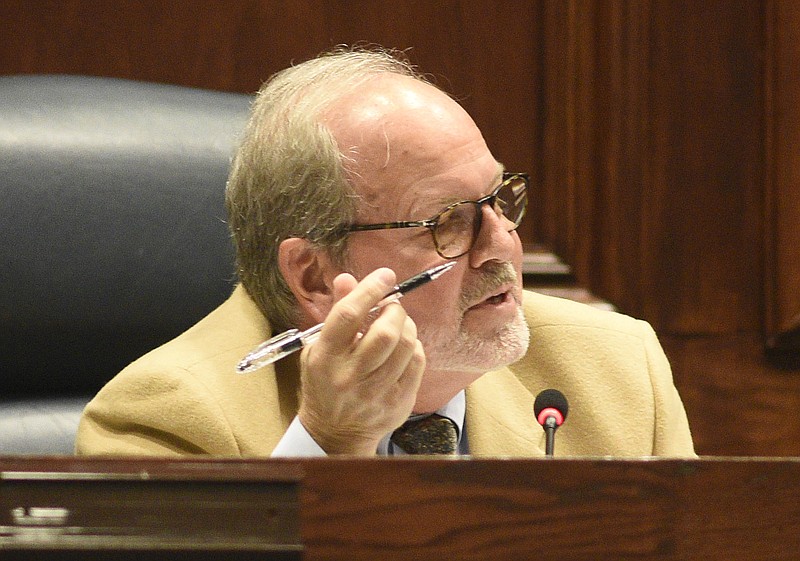The voices of "Delay, Delay, Delay" that populated the Hamilton County Commission and the public at Tuesday's meeting may not yet know what they tried to stop.
The 11-district county map that commissioners approved 6-3 - following a redistricting process required by the decennial census - could, following next August's general election, give Blacks their largest-ever presence on the commission and the most Democrats on the panel since four were elected in 2002.
Yet, commissioners and audience members still cried that "voices won't be heard," that "we have not had the chance to be involved," that "we all deserve fair and equal representation," that "some of us are supposed to take what we're given and be OK with it," that "no one's looking at fair maps," that "we're doing a disservice to the people of our county," that the commission should be "more understanding about communities of interest," that "voices are going on deaf ears," and that "gerrymandering tactics [were being put in place] to water down the vote."
We would ask of those voices, as attorney Joseph N. Welch did of Sen. Joseph McCarthy at the 1954 Army-McCarthy hearings, "Have you no decency, at long last? Have you left no sense of decency."
One, two or four more weeks of delay wouldn't be able to substantially change the map since the current nine commissioners decided on the 11 districts more than a month ago, and there is very little wiggle room for such changes even they wanted to make them.
(District 6 Commissioner David Sharpe, who noted his new border was "drawn as well as it could be," offered two separate motions for the commission to consider 18 districts Tuesday but was outvoted 6-3 both times.)
Most significant among the motivations of the redistricting body throughout its six-week process was to keep the two majority minority districts on the commission. That's the way they were intentionally drawn when the county moved to the commission form of government in 1978, as County Attorney Rheubin Taylor pointed out, and he said it would be "ill- advised" to go down to one.
The problem with maintaining the two districts, as District 8 Commissioner Tim Boyd patiently explained to the room (and which we had elucidated in this space weeks ago), is that minority residents of the county are no longer as concentrated in Districts 4 and 5 as they once were. They have spread throughout the county, which was one of the goals of civil rights proponents 60 years ago - that people could live where they wanted, and is, as Boyd said, "a very, very good thing."
So, during the weeks-long process, when District 4 Commissioner Warren Mackey and District 5 Commissioner Katherlyn Geter frequently wanted to tweak their districts to pick up this census tract or that one, the result would move the district out of majority minority status or stretch the total deviation of district populations beyond the 10% allowed by law.
In the end, only one proposal made by any commissioner (that was voiced during a workshop) was ultimately denied. That was Geter's attempt to stretch her new district to encompass Harrison Elementary School. She has represented the school only since it opened earlier this year. Before that, the old school was in District 9 because it is a feeder school for the adjacent J.B. Brown Middle School and Central High School.
Several weeks ago, Geter said it was vital that Bess T. Shepherd Elementary be included in her new district since it was a feeder school for the nearby Tyner Middle and Tyner High Schools - and that change was made for her - but on Tuesday she said she would give that up to keep Harrison Elementary. District 9 Commissioner Steve Highlander opposed the move, and the commission voted down a motion to make the change 5-4.
The two new districts will be District 10 in eastern Hamilton County, carved out of the districts of Highlander and Commission Chairman Sabrena Smedley, and District 11, beginning in the southwestern-most edge of the county and extending along its border with Georgia up to Missionary Ridge, taken largely from Sharpe's and Mackey's districts.
Based on voting patterns, District 10 is likely to be a Republican district, while District 11, with a large concentration of Democrats east of Lookout Mountain, should lean Democratic.
The map will now be submitted to the state for review and approval.
Whether the county will have nine or 11 school board members is not expected to be settled until early 2022, when state legislators could make a change in the law to allow for 11 mirror districts instead of the current nine.
All nine county commissioners should be proud of the transparent and public-involved process in which the new map was drawn - though some said they were not - and we hope members of the "delay" crowd will look beyond their petty prejudices and see the result for what it is. It might surprise them.
